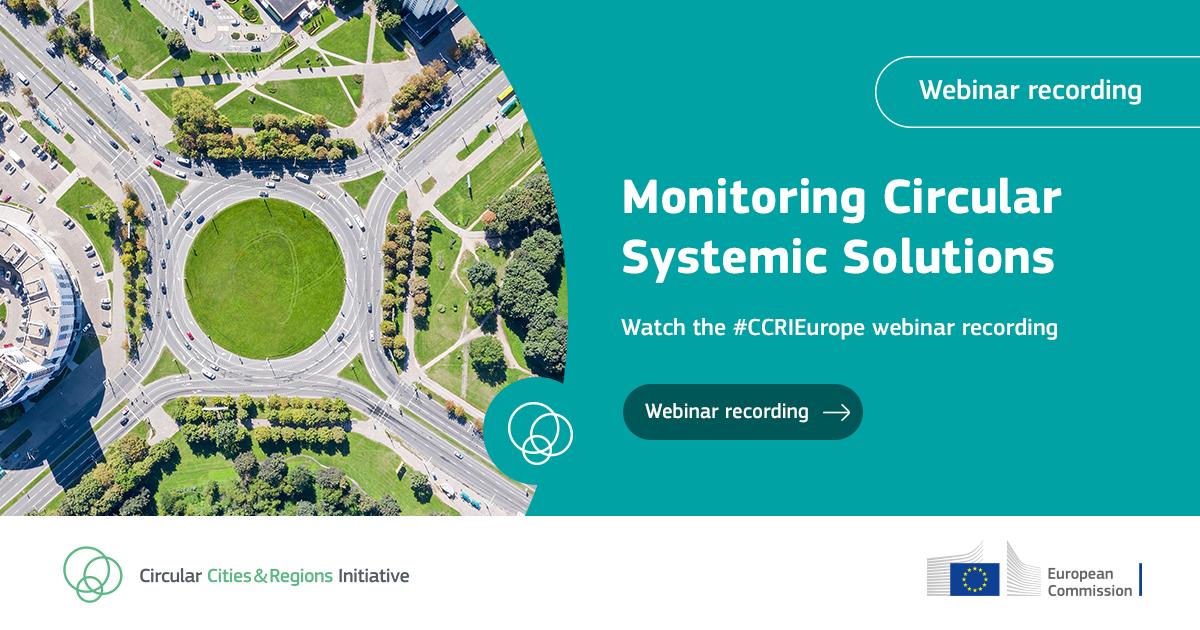Webinar on Monitoring the Transition to Circular Economy
Updated on 19.09.2023
The webinar focused on the concepts and challenges of monitoring the transition to a circular economy. Drawing on experiences from the ground, it discussed practical examples from cities and regions and related challenges. A brief presentation of the Self-Assessment Tool, which is being developed by the Circular Cities and Regions Initiative Coordination and Support Office (CCRI-CSO), was also on the agenda.
Circular Cities and Regions Initiative Coordination and Support Office
More information
Monitoring the circular economy transition is a complex and challenging issue. There is no one-size-fits-all solution. Cities and regions are struggling with many aspects of monitoring – from data availability to setting up meaningful targets. However, it is possible to start from what is available and work towards improvement.
There is a need to explore further holistic approaches that go beyond waste data and include economic and social aspects of circular economy. However, this seems to be unavailable in most territories.
Relevance for Circular Systemic Solutions
Monitoring the outputs and outcomes of Circular Systemic Solutions is essential for better policymaking at local and regional level. The webinar provided inspiring examples of good practices from cities and regions across the EU. This webinar was relevant both for the Pilot and Fellow cities and regions of the CCRI and the wider audience dealing with circular economy initiatives.
Key messages from presenters:
Jannis Lambert (CCRI-CSO) introduced the concept of monitoring and its complexity in relation to circular economy. The variety of metrics associated with circular economy and diversity in the way indicators are composed or calculated is significant. As a result, there is a lack of an agreed definition and approach to monitoring. Mr Lambert then explained that a Theory of Change-based approach can provide a framework for learning, iterative monitoring and evaluation. Mr Lambert concluded that despite the difficulties, monitoring can lead to better decisions, help steer better processes, contribute to better outreach to stakeholders and help achieve better results. However, there is no standard solution. In this context, the SMART framework can help set bold targets.
Mr Lambert’s presentation was followed by a presentation of the CCRI Methodology and its links to monitoring by Marco Bianchi (CCRI-CSO). In 2022, the CCRI office developed a methodology for the implementation of circular systemic solutions. Mr Bianchi explained that the CCRI Methodology defines a monitoring framework for cities and regions in which indicators are classified into five key areas: production and consumption; waste management; secondary raw materials; competitiveness and innovation; and governance. The CCRI Methodology also offers a list of exemplary indicators. Finally, Mr Bianchi anticipated that the methodology will be updated this year.
Tim Bichlmeier continued with a presentation of the CCRI Self-Assessment tool for cities and regions (currently in development). The goal of the tool is to provide a monitoring system for the implementation of circular systemic solutions and enable the transfer of relevant data and knowledge. In terms of functionality, the user selects relevant indicators to measure the progress of circularity and visualises the data inserted, which is intended to support decision-making processes. The plan is to gather feedback from Pilots first, and then from Associated Partners (experts on the topic) and Fellows to ensure the tool is adapted to the users’ needs. Once the testing phase is over (third quarter of 2023), the tool will become publicly available.
The last block focused on practical examples from cities and regions on monitoring:
- Kristin Hansen from the Department for Sustainable Development of the Møre and Romsdal County, Norway (Fellow) described the successful county’s work on data collection and monitoring. In 2020, the county ran the Sustainability Region project where it carried out a mapping of the sustainable development goals, using the same method, in the 26 municipalities of the county. The county provided support and coordinated the work. The data collection process is described in more detail in this report.
- Sophie Druenert, from the Senate Department for the Environment, Urban Mobility, Consumer Protection and Climate Action of the city of Berlin, Germany (Fellow) explained that Berlin has an advanced system since 2010. They collect data on 37 non-hazardous waste types and analyse it from three perspectives: material flow; climate footprint; and environmental footprint. For monitoring progress, they have goals and compare between waste types across years and between treatment plans. All this information is compiled in a report.
- Elmar Willems and Kris Van Looy from the Public Waste Agency and Circular Flanders, Belgium (Pilot) highlighted that the region counts on a digital registration system for waste flows, MATIS. This involves many actors (including transport, processing, etc.), as well as multiple data layers. Moreover, Flanders also has a platform called Circular Economy Monitor Flanders, containing more than 100 indicators related to different circular economy areas.
- Alessandro Pensa, from the Mayor’s Cabinet in Capannori, Italy (Pilot) shared that 21 material flows are being measured and that a monthly report (compiling information from various recycling centres related to material flows, weight flows for each material and difference with previous years) is being prepared. The regional authority (Agenzia Regionale Recupero Risorse) receives and certifies the data annually, so that it can be published online (here).
- Gisela Somer, from the Waste Agency of Catalonia, Spain highlighted that waste management facilities in Catalonia must sign up to the Register of Waste Managers and submit an Annual Waste Declaration. Furthermore, industrial waste producers (mainly small and medium-sized enterprises) must sign up to the Register of Industrial Waste Producers and submit an Annual Waste Declaration. There is an online platform for waste management stakeholders (set up in 2002) that facilitates registration, documentation, declaration and consultation.

e.g. NGOs, citizens associations



